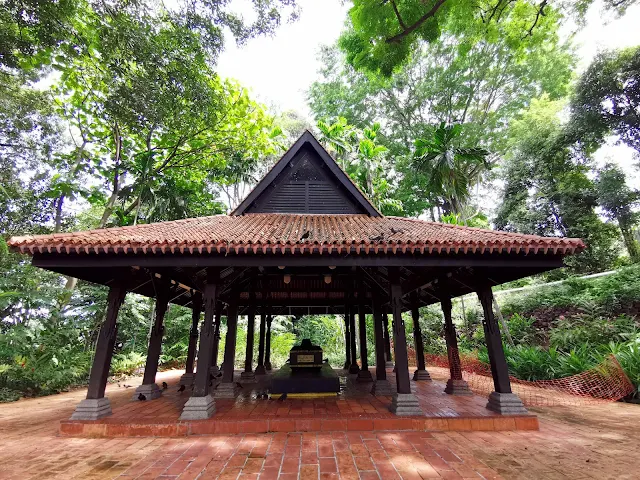Keramat Iskandar Shah at Fort Canning Park is a shrine dedicated to Sultan Iskandar Shah who was the last king of Singapura and the first Sultan of the Malacca Sultanate.
The structure we see today (2020) was built in the 1990s but the shrine itself is much older than that.
When Raffles and Farquhar landed at Singapore River in 1819, Temenggong Abdul Rahman told them that the heavily forested hill overlooking the river was Bukit Larangan (Malay for Forbidden Hill). Commoners were not allowed onto the hill. (Image of Singapore River and Bukit Larangan in 1823 courtesy of Wikipedia.)
Based on
records in the Sejarah Malayu (Malay for
Malay Annals), there was a
kingdom of Singapura
between 1299 to 1398 located at Singapore River and Bukit Larangan. Ancient kings once lived and were buried at Bukit Larangan. The palace ladies bathed in a spring at Bukit Larangan which was out of bounds to commoners.
The local Malays refused to climb the hill with William Farquhar, the first British Resident (governor) of Singapore. Farquhar did it anyway in 1819 with the help of some Malaccan Malays and raised the Union Jack. Henceforth, Bukit Larangan became Bukit Bendera (Flag Hill).
On a side note, Canadian Prime Minister Justin Trudeau's great-great-great-great-grandmother Esther Farquhar Bernard is the eldest daughter of William Farquhar, the first British Resident from 1819 to 1823. She was buried at Fort Canning Hill in 1838 about 100 metres from Keramat Sultan Iskandar Shah. (Source: Straits Times)
"... on the north declivity of the hill, ..., is said to have been the
burying-place of Iskandar Shah, King of Singapore.... ." (Map of Fort
Canning Hill in 1825 courtesy of
Wikipedia. The approximate location of Keramat Iskandar Shah marked with
< ).
In the three years since 1819, locals and newly arrived immigrants started to climb the once Forbidden Hill. (Map of Fort Canning Hill in 1884 courtesy of NAS. The approximate location of Keramat Iskandar Shah marked with < ).
John Crawfurd described Keramat Iskandar Shah in 1822:
"Over the supposed tomb of Iskandar, a rude structure has been raised,
since the formation of the new settlement, to which Mohammedans, Hindus,
and Chinese, equally resort to do homage."
Image of Keramat Iskandar Shah in 1930 from the guidebook The Lights of Singapore by Roland Braddell published in 1934. To access the shrine, visitors had to cross a wooden bridge over a trench. The trench no longer exists today (2020).
The shrine is dedicated to Sultan Iskandar Shah though historians just
like John Crawfurd consider it apocryphal i.e. not authentic. Sultan Iskandar Shah also
known as Parameswara was the fifth and last monarch of the kingdom of
Singapura. (Image of Parameswara courtesy of
Wikipedia.)
After enjoying 99 years of prosperity, in 1389, a foreign power either Siamese or Javanese sacked Singapura and
razed it to the ground. Parameswara escaped to Malacca and founded the
Malacca Sultanate. Parameswara became Sultan Iskandar Shah after
converting to Islam.
Sultan Iskandar Shah died in 1414 in Malacca. It is said that his body
was brought back to Singapore and buried at Bukit Larangan where Keramat
Iskandar Shah is located. However, historians have so far not been able to
find evidence to support this belief.
This exquisite 14th-century Javanese Majapahit gold ornament was excavated at Bukit Larangan near the shrine. The motif depicts Batara Kala, the Hindu god of time and destruction, and creator of light and the earth. (This gem is displayed at the National Museum of Singapore.)
However, evidence of the identity of the tomb's occupant has not yet been discovered. The origins of the shrine remains a mystery.
Today, Keramat Sultan Iskandar Shah is revered by Muslims. Many families come here during Ramadan to break fast.
For myself, Keramat Sultan Iskandar Shah reminds me of the ancient kingdom of Singapura where the story of Singapore began.
The path leading to Keramat Sultan Iskandar Shah is lined with herbs and spices. Some visitors say their fragrance make them feel a certain presence at the holy place.
References:
Date: 12 Oct 2020















Hi
ReplyDeleteThere has been a new founding thru spiritual and enlightenment from The Almighty, this tomb is confirmed belonging to Sang Nila Utama (founder of Singapura) the 5th son of Sang Sapurba and Wan Sendari. SANG Sapurba also adopts the name of Sang Nila Utama and they are the direct descendent of Alexander The Great. Sang Sapurba came from India and not Srivijaya empire.
We hope there are archaeology and historian who will be able to conduct further investigation on this tomb and confirms further that it is the grave of our first King.
Parameswara, the great grandchild of Sang Nila Utama was buried in Malacca.
Hello,anonymous.i am a student from Singapore and is there really someone buried under Keramat Sultan Iskandar Shah
ReplyDelete